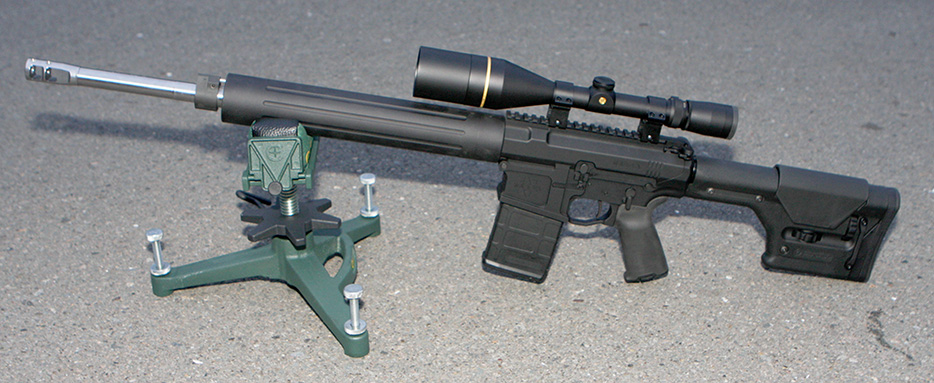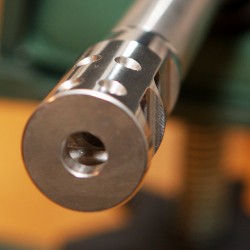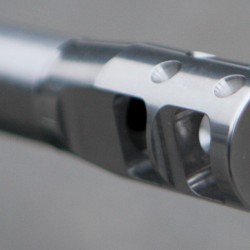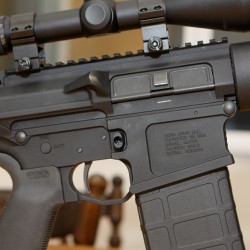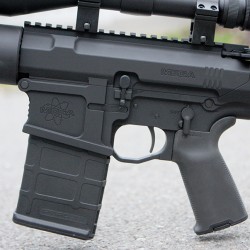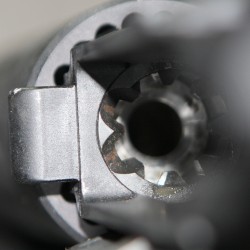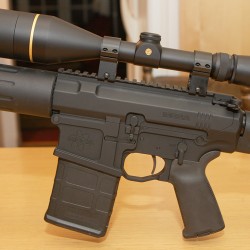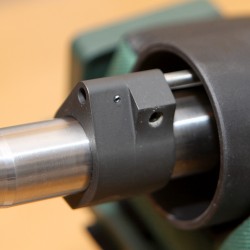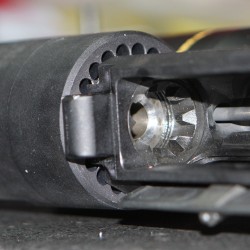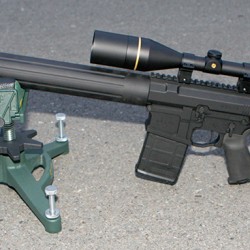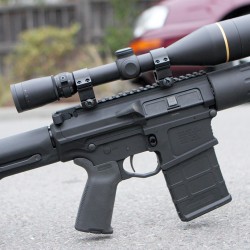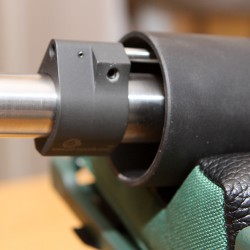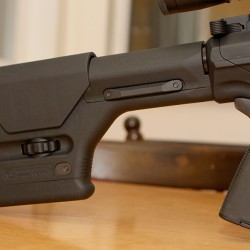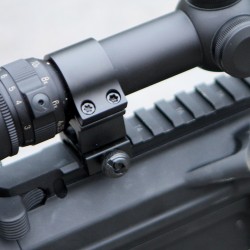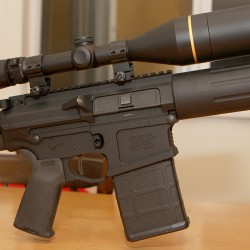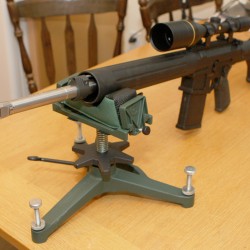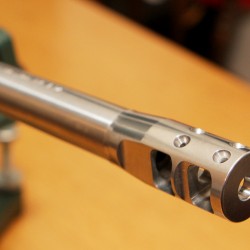The dedicated marksman rifle (DMR) – A rifle designed to fill the gap between an assault and sniper rifle. A battle rifle that can maintain accurate rapid fire at ranges up to 600 yards.
I decided that it was time to invest in a nice rifle. Something that I could shoot long range (up to 300 yards) bench-rest and handheld marksman positions. I wanted something a serious rifleman would like. I also wanted to put some time into learning what goes on behind gunsmithing and gun assembly. At first I was looking at tactical versions of the Remington 700 bolt action classic but later decided to base my project on the Knight’s SR-25 EMR rifle. Since the Knight’s SR-25 is a ‘listed’ gun in California, that was impossible. With some research, I decided to start building from a high quality .308 AR receiver set, the Mega Machine MA-TEN .308 combo.
I have a couple of pistols, a Beretta 92FS (9mm Auto) and a Ruger LCR (38 special +p Revolver). I love shooting the 92 and don’t care much for the LCR. They have different reasons for being so that is easily explained. Recently, I was on a trip to Nevada and did a bunch of outdoor pistol shooting. It was so much nicer than the indoor that I’ve mostly done. Still, I was jealous of the guys shooting rifle and figured I should get one on line. It will really be nice for trips to Florida visiting my father. One nice thing to do in Florida.
I’m putting the gun together as a real field rifle, not an assault rifle. No bi-pod, no excessive tac rails, a solid but lighter than bull barrel (M110). A 10x scope for real shooting. Nothing around me is over 300 yards. I’m hoping for as much freehand as bench-rest shooting with it.
I went a bit overboard with the parts behind this gun given my experience in general. I excuse that with doing a huge amount of my usual level of research that will hopefully be clear in the whole package as well as it’s assembly. I really needed to take my mind off of not being able to ride bikes and geeking out on something new has been refreshing.
Hopefully, the learning I get done on this project will branch out into quite a few more gun projects.
The receiver
It’s very nice. I wish it were forged like many of the .223 receivers but I’m sure it’s just as strong as it needs to be. The immaculate attention to detail is what drew me to this set. They really spent their time constructing this right.
Mounting the barrel, Port info, and twist
Barrel: Fulton Armory Barrel, 20″, .308 AR, M110, 1×12, Stainless, Threaded, Match Quality, FA by Criterion (#FA-TU-005-SS)
This barrel is very nice looking. Cosmetically the only thing that I can complain about is the stampings for the barrel data. If it were machine cut it would be an amazing looking peice.
End of case to end of extention: 0.47″
End of case to end of barrel: 20.00″
End of case to center of gas port: 13.38″
Center of gas port to end of barrel: 6.75″
Gas port diameter: 0.088″
Barrel diameter at gas port: 0.875″
Barrel extention diameter: 1.185″
Barrel diameter at threaded end: 0.845″
End of barrel to thread shoulder: 0.735″
Concentricity of barrel extention to barrel: 0.0020″
Barrel runout: 0.0010″
Concentricity of chamber to OD: 0.0010″
Concentricity of bore tip to OD: 0.0020″
Barrel diameter at barrel extention: 1.198″
Barrel extention diameter at barrel: 1.198″
Chamber diameter: Tapered 0.75 degrees. To difficult wihout special tool.
Max pin diameter through bore: 0.299″ (spec – .300″ bore, .308″ groove)
Measured twist of barrel: Not measured yet
Number of rifle grooves: 4
Barrel weight: 1633 grams (3.6 lbs)
Shim: Precision Brand Stainless Steel Shim Stock.
Retaing compound: Loctite 609 Retaining Compound.
Thread Grease: Loctite Moly 50
The twist on this M110 barrel is 1/12. That theoretically corresponds to bullets between 168-170gr. .308 round. A simple enought place to start. Some seem to say a 1/11 twist is good for that load. If I decide to start shooting bullets heavier or lighter than the 168gr. standard then another twist rate may be in order. More twist for heavier loads, less for lighter.
Greenhill Formula, a common rule of thum for calculating barrel twist.
T=((C*D^2)/L)*(SG/10.9)^(1/2) (Note: For velocities in excess of 2,800 fps, substitute 180 for 150)
T = twist rate per inch
D = bullet diameter in inches
L = bullet’s length in inches
SG = Bullet specific gravity (10.9 for solid lead)
C = 150 if < 2800 fps, 180 if > 2800 fps 132 ≈ 1250 fps
Sierra .308 dia. 168 gr. HPBT MatchKing-
Diameter: 7.83mm (.3083″)
Length: 30.52 mm (1.2016″)
Specific gravity: 10.79
Muzzle Velocity: 2650 fps.
T=((150*0.3083^2)/1.2016)*(10.79/10.9)^(1/2)
T= 11.81
Later I may look more into the Miller stability values. (1.76 for 168, 1.68 for 175)
Bullet RPM
MV x (12/twist rate in inches) x 60 = Bullet RPM
2650 ft/s * (12(in/ft)/12 (in/rot)*60 (s/min) = 159,000
Headspace
This is an interesting topic. Civilian cartridges and chambers are specified by the Sporting Arms and Ammunition Manufacturers’ Institute (SAAMI). The 308 Winchester specification print can be found here. You can see that the headspace specification, datum diameter 0.400″ along the 20 degree shoulder, is 1.630-1.640″ for the chamber and 1.627-1.634″ for the cartridge. Obviously, there is an issue here. Essentially, the specification for the chamber is far too loose and will overlap the cartridge dimension. This is corrected on US Military and NATO specification but not for civilian use.
Typical checking of the headspace is done using GO, NO-GO, and FEILD gauges. When the firearm is new or after servicing, the GO (1.630″) gauge should fit and the NO-GO (1.634″) guage should not. In time and with use, the firearm will wear and should not be used once the FEILD (1.638″) gauge will chamber. This is all simple enough but it doesn’t really tell us much other than that the gun is ‘safe’ to use regarding this parameter.
Given the overlap in tolerances for chambers and cartridges, and that we have no control over the production of the cartridges (without hand loading), we need to set a different goal for our headspace dimensions. Obviously, that should be 1.634-1.638″. Quite a bit tighter. Really, as close to 1.634″ would be best. The rifle that I put together ended up with headspace in the range of 1.630-1.632.
The only way we can measure this is buy getting a full set of gauges. Forster Products (# HG308MST) has a full 11 piece range that will get this done. There isn’t much competition here regarding the specific sizes between the GO and FEILD sizes.
It is also very important to remember that .308 Winchester and 7.62×51 NATO do not have the same chamber specifications and should not be confused. Buy 308 ammo for your 308 gun and vis-a-vis.
Headspace Gage lengths for 7.62mm
Go Gage……………………………….. 1.6355″
NO Go Gage………………………….. 1.6375″
Rebuild Maximum Gage………….. 1.6415″
Field Reject Gage………………….. 1.6455″
Adjustable Gas Block
With a 20″ barrel and rifle length port drilling, this gun should work well with a large variety of ammunition right out of the box without having to use any type of adjustment on the gas port. The pressure of the gas pulse and the duration of it are exactly as the original rifles were designed. The gun should also feel fairly comfortable to shoot. Regardless, I fit an adjustable block to the barrel for fine tuning.
Ammunition
My understanding is that even though things will be good as is, there are improvements that can be made with the addition of an adjustable gas block. This has to do with very fine tuning of the gas system but also tuning around my chosen ammunition. Initially, I’ve ordered a bunch of Federal Gold Medal Match .308 168gr Sierra Matchking (GM308M) cartridges and a few boxes of Federal Gold Medal Match .308 175gr Sierra MatchKing (GM308M2) and Federal American Eagle .308 150gr (AE308D). The large frame AR was designed around the 168gr round so tuning around that should give me some range into the lighter and heavier bullet. 1 grain = 0.0647989 grams
Sierra info:
168 gr HPBT
average mass: 10.8952 g
average length: 30.52 mm
average volume: 1.01 mL
average diameter: 7.83 mm
average specific gravity: 10.79
twist rate for specs above: 11.8 in to 1
muzzle velocity: 2650 ft/s
175 gr HPBT
average mass: 11.3437 g
average length: 31.42 mm
average volume: 1.02 mL
average diameter: 7.83 mm
average specific gravity: 11.12
twist rate for specs above: 11.6 in to 1
muzzle velocity: 2600 ft/s
The Scope
I wanted a high quality and versatile scope for this rifle. Given that I wanted to do a lot of different kinds of shooting with it I chose an adjustable Lupould VX-3 3.5-10x. Sure, lots of adjustables will go to much higher magnifications but there is a drawback in that to keep any decent optical clarity and light the cost would have to rise just as much. Honestly, spending $2k on a scope is really not in my plans right now. I chose the 50mm objective because I’ve got plenty of room on an AR to mount it and more light range will be nice if I’m in the woods. If this were a Remington 700 I would have gone with the 40mm. I’m just hoping that this works out. I’m thinking of doing an iron sight AR22 carbine as a fun gun next so this scope should be around for a while.
Rail Height over bore: 1.3125″ (MA-TEN)(AR-15 1.2188″)
Scope height over rail: 1.250″ (1.250″ B-Square, Lg)
Scope height over bore (HOB): 2.5625″ (2.6″ std for iron sights)
Some measured information:
Barrel nut threads: 1 7/16″ x 16tpi
Upper receiver barrel bore diameter: 1.1875″
Barrel extention diameter:
Upper receiver BCG bore diameter: 1.195″
Upper receiver BCG guide grove: 0.416″
BCG guide lug width: 0.402″
Weights:
Buttstock: 777.3g.
Rifle, naked: 4880g. (10 11/16lbs)
Rifle, w/scope: 5430g. (12 lbs)
Rifle, w/scope & 10 rounds: 5850g. (12 15/16lbs)
Scope Rings:
I purchased the cheapest available during setup. Fine quality versions will be procured after determining fit. Given that I have the scope set at 2.5625″ over the bore and have about 1/4″ to spare, I will be shopping for rings that have just over about 1.125″ of rise.
Sling and Sling mounts
I’m still working on this. Later.
Nice references:
Hellbender on Snipershide forum
300sniper on the internet – YouTube, Practical Machinist, etc.
Final thoughts:
I like how this gun turned out. It’s got a super cheap handguard on it that will allow me to hack into hard without feeling bad. I’d like to do a custom small diameter off center guard like the JP stuff. We’ll see what happens in time.
The final weight of the gun is a bit much for handheld shooting. It’s be nice to cut 2.5-3 lbs off. I’m thinking of tracking down a lighter 18″ barrel and lighter custom buttstock. In the end it may be cheaper to get another gun going for lighter shooting.
Parts List:
| Upper/Lower Combo | Mega Machine | MA-TEN .308 | M308-0903 |
| Scope | Leupold | VX-3 3.5-10x50mm | 66270 |
| Barrell | Fulton Armory | 20″ M110, 1×12 by Criterion | FA-TU-005-SS |
| Stock | Magpul | PRS AR10/SR25 – BLK | MAG308BLK |
| Trigger Assembly | Timney | Single Stage Match Triger – AR10 | TimneyAR10:670 |
| Bolt Carrier Assembly | DPMS Inc. | DPMS .308 | DPMS:308:BCG |
| Compensator | JP Rifles | Standard-Profile Compensator | JPTRE-424S |
| Small Parts | DPMS Inc. | M16/AR-STYLE .308 LOWER RECEIVER PARTS KIT | RPK308 |
| Gas Block | Precision Reflex Inc. | .875 Adjustable Gas Block with Straight Gas Tube | 03-875-02GT |
| Tube Assembly | DPMS Inc. | .308 MIL-SPEC TUBE ASSEMBLY | 308-CS-09M |
| Handguard | DPMS Inc. | .308 Standard Length Free Float Tube | |
| Magazine | Magpul | PMAG 20LR Kit & CA Mod | Gun Show |
| Lens Shade | Leupold | ScopeSmith Lens Shade, 2.5in Long, 50mm Dia. | 52350 |
| Grip | Magpul | MOE+ Grip – AR15/M16 | MAG416BLK |
| Buffer | DPMS Inc. | 308-BS-11 | |
| Gas Tube | Fulton Armory | Gas Tube, Rifle | FA-AU-118-T |
| Buffer Spring | Heavy Buffers | ||
| Scope Rings | B Square | Sport Utility Rings (high) | 20056 |

